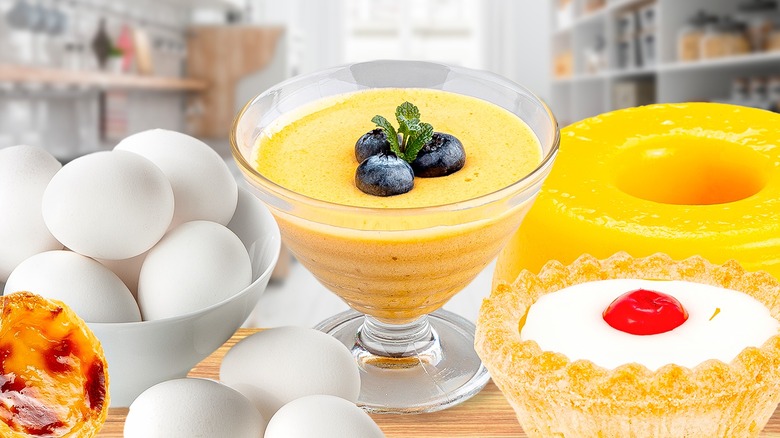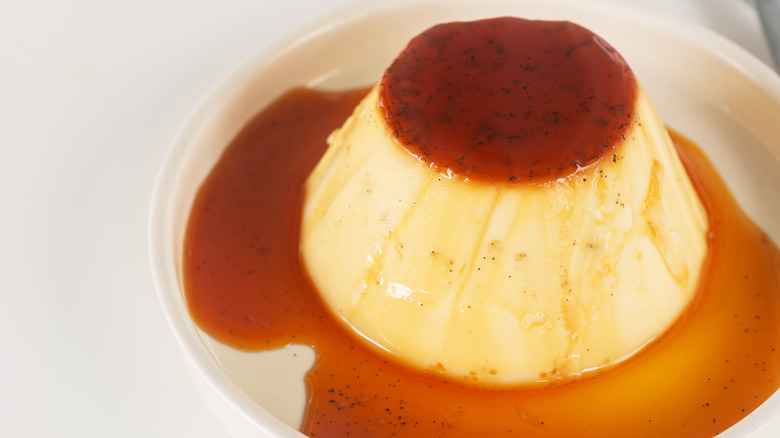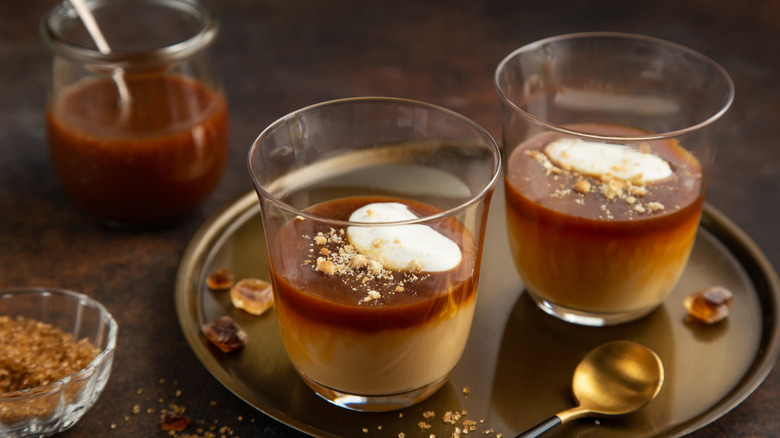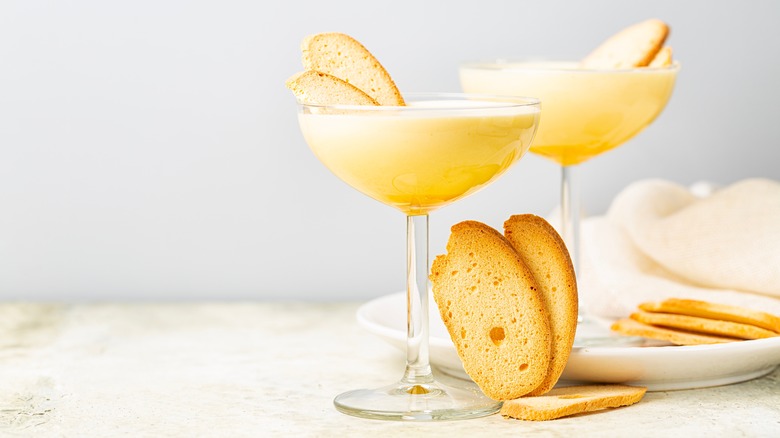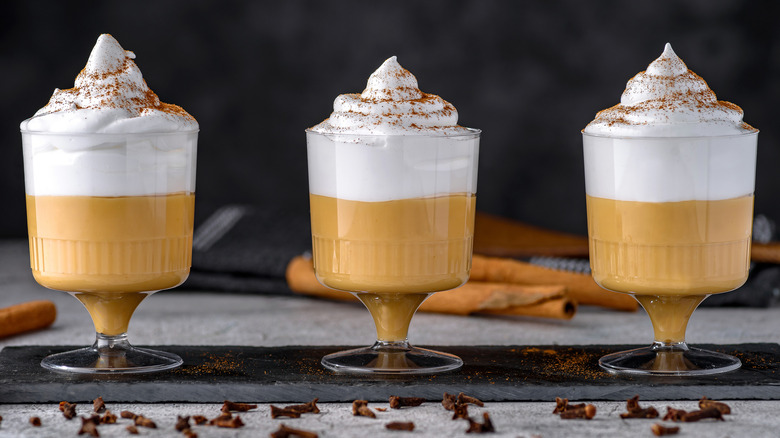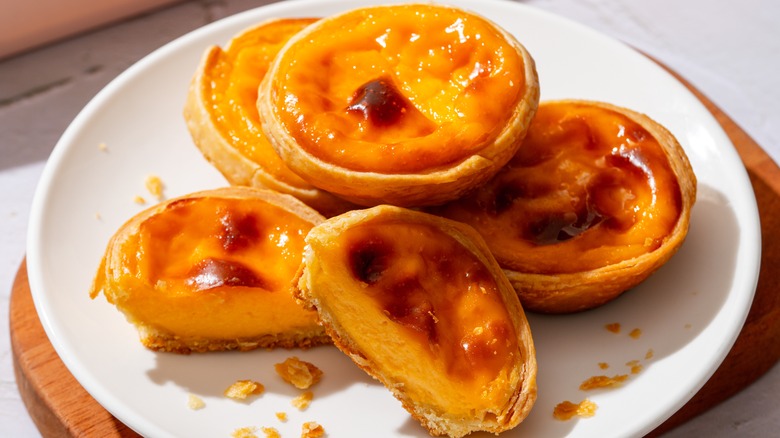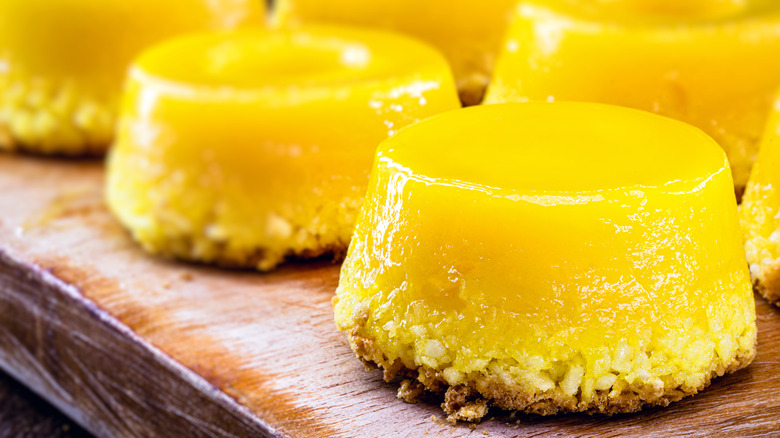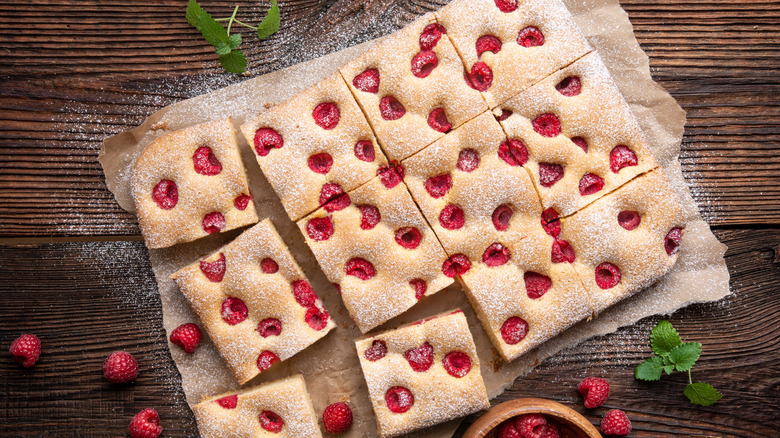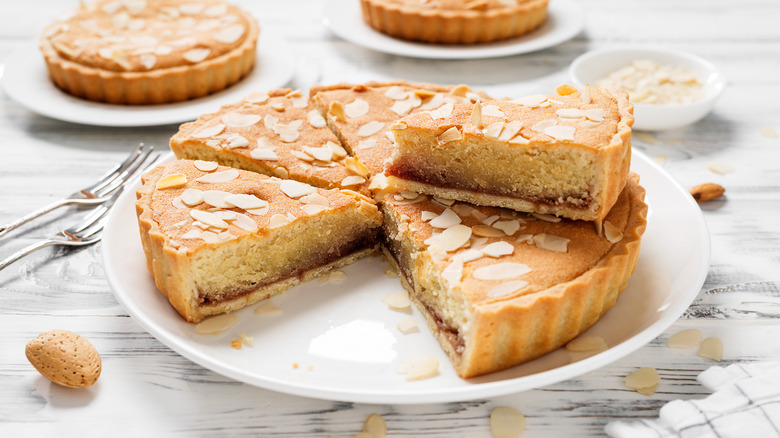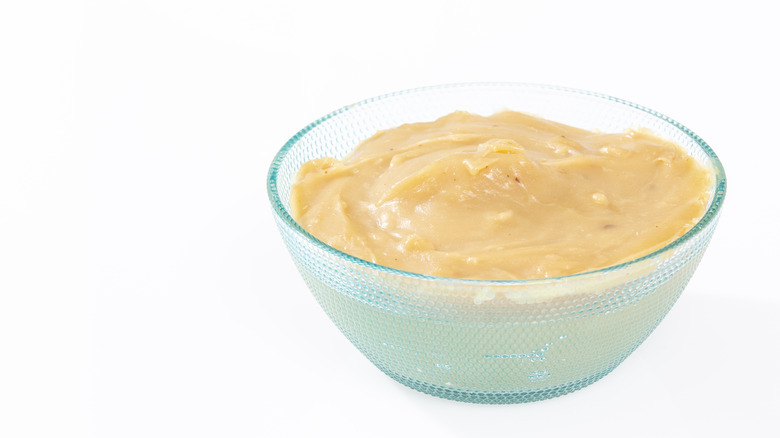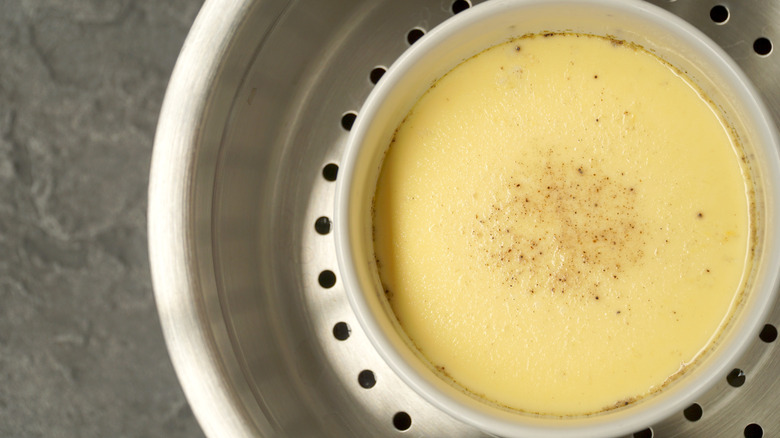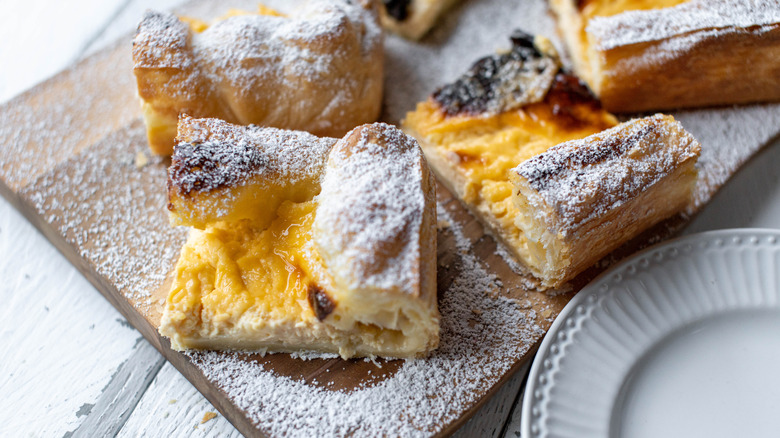11 Egg-Based Desserts From Around The World
Eggs have had a mighty impact on desserts around the world. Due to trade and colonization, custards have exchanged hands throughout the ages. Modern-day cheesecake, for example, has its roots in the Roman Savillum, a savory, egg and ricotta snack that fueled long days of work. But the proteins found in eggs can do more than fuel a Roman soldier. Whisked together with just a few other ingredients, the humble egg creates creamy textures and adds richness to custards around the globe.
How does it work? The proteins in egg whites and yolks break down and regroup during the cooking process, becoming a thickening agent that creates the iconic gel-like consistency found in jiggly, stand-alone puddings or the silkiness in ice cream. In varying combinations of sugar, milk, and heat, eggs provide the backbone for a number of desserts the world over. And though each recipe relies on the quintessential properties of eggs, each is a unique example of its culture's flavors and culinary influence.
Japanese purin
For fans of flan, one of Japan's most popular desserts could become a new favorite. Found in cafes all over Japan, purin (a Japanese word for "pudding") can be baked (yaki-purin) or steamed (mashi-purin). Convenience stores carry instant purin, and bakeries make all kinds of specialty flavors and shapes. Purin is so popular that Sanrio (the maker of Hello Kitty) has a character named PomPomPurin. With a little technique, purin is also easy to achieve at home.
Baking purin in a warm water bath in the oven ensures even cooking, but these puddings can even be made in an Instant Pot (which uses the steaming method) for an oven-free dessert. Like flan, Japanese purin includes a caramel base that is poured into the bottom of the pans. Once the puddings cool enough to flip over, the caramel will self-sauce the purin. Most purin recipes call for both whole eggs and an extra yolk to get the velvet-smooth mouthfeel similar to crème brûlée. The eggs in the recipe also allow for the custard to keep its shape after being removed from the pan. Once cooled and flipped, the custard is ready as is or can be topped with additional flavorings. Think boba, whipped cream, and fruit.
Italy's budino
This custard may be Italian, but its origins trace back to Medieval England when puddings were savory, meat-filled affairs. Not so with Italian budino, a rich custard often flavored with coffee, deeply cooked caramel, or dark chocolate. Notably thicker than American pudding, thanks to cornstarch in addition to egg yolks, budino has seen a surge in popularity in the U.S. Perhaps that's due to its comforting richness and elegant flavoring.
In this recipe for salted caramel budino, maple syrup and brown sugar create a deep roasted sugar flavor, and the powers of cornstarch and egg yolks combine for extra thickness. Cornstarch and eggs are a thickening superpower, but using cornstarch requires special attention to cooking time. Cornstarch's thickening properties take effect once it reaches a certain temperature, so be sure to stir until the whisk leaves streaks in the pudding. Your nose will be able to pick up when the custard is done, as well. It will smell sweet and delicious.
Budinos are often served with a cookie crust or crumble, and topped with homemade caramel or ever-so-lightly-sweetened whipped cream. Consider baking them in glass jars for a dynamic visual.
France's sabayon
Adapted from the thicker egg-based, boozy Italian zabaglione, the French added this creamy concoction to their repertoire of sweet sauces. Sabayon is traditionally made with just egg yolks, sugar, and a fortified wine like Marsala, though it can also be made with white or sparkling wine for a festive addition to the holiday table. Ideally served fresh and warm, it requires some attention at the stove to achieve the right consistency. When making sabayon, which falls somewhere between beverage and sauce, the wooden spoon trick works wonders. You'll want to whisk your three ingredients over a bain marie until it reaches a consistency similar to creme anglaise. Whisk constantly to avoid any scrambled egg mishaps.
Served on its own, sabayon could be a festive dessert akin to egg nog (Champagne sabayon would be quite a way to ring in the New Year). Incorporated with another sweet dish, it can serve as a creme anglaise substitute for flourless chocolate torte or poured over a trifle or a pavlova. However sabayon is served, it's a party-friendly addition to the table.
Peru's suspiro de Limeña
Suspiro de Limeña translates to "sigh of the lady from Lima" and is a caramel Peruvian dessert sure to satisfy your sweet tooth. Consisting of a custard of condensed and evaporated milks, egg yolks, and topped with fluffy meringue, the name was coined by Peruvian writer José Gálvez Barrenechea after describing its texture as "a soft and sweet sigh of a woman." It most likely takes inspiration from manjar blanco, which in the Americas is akin to dulce de leche.
The dessert consists of two layers, a manjar blanco base of condensed and evaporated milk and egg yolk and a layer of meringue on top. The first step is to cook the condensed and evaporated milks until they caramelize, and then make a custard by tempering in the egg yolks. The leftover egg whites are whipped up into a meringue, along with a sweet wine for an extra kick. This dessert is quite sweet, but pairing it with a tea or glass of pisco, the Peruvian grape-based spirit, can cut through the sweetness.
Pastel de nata from Portugal
The original recipe for pastel de nata was developed by monks of the Hieronymites (or Jerónimos), who sold the recipe in 1837 to the confectionary Fábrica de Pastéis de Belém in Lisbon. Today the shop reportedly sells about 20,000 a day of these beloved treats, keeping the original recipe a secret.
Pastel de nata are a unique dessert and a symbol of Portuguese identity. Though they might look like simple tarts, these hand-sized desserts have a crispy, slightly salty pastry shell ("massa folhada," which is akin to puff pastry), that gives way to a creamy, egg-yolk based filling with lemon and cinnamon undertones. Darkened spots on the filling provide even more flavor. There are several tips for making egg tarts, from experimenting with egg yolks, to what kind of flour to use, and different baking methods. One essential element is to sweeten with a simple syrup, pouring it into the egg mix is essential to stabilize the custard while ensuring a near-gooey filling. Pastel de nata are good cold or warm and often dusted with cinnamon and powdered sugar.
Quindim from Brazil
Quindim are custard cakes made of egg yolks, sugar, and coconut flakes and baked in molds, and originate from Northeast Brazil, where they developed with a confluence of West African and Portuguese influence. Meanwhile, the method itself seems to descend from the Portuguese brisas do lis, which calls for almonds. The chefs in the kitchen of Brazilian homes during Portuguese colonization were often enslaved Africans, who named the dessert quindim, a Bantu word for "the typical gestures, behavior, and humor of adolescent girls." Egg-based desserts were common in Portugal, where the origins of quindim were made with almonds. Instead of the almonds found in Portugal, the African cooks substituted coconut, which was abundant.
The ingredients are blended together over a bain marie, poured into a container (try mini muffin tins for small quindim, or you can go as big as a full-size flan), and then baked with a water bath in the oven, like a cheesecake. As it bakes, the coconut floats to the top so that when flipped over, you have a crispy bottom and an almost-gooey center. It's important to remove the custard when it's warm (too hot and it could break, too cold and it might stick to the mold). It is now one of the most popular desserts in the country and can top off a dinner at a churrasqueria.
Czech bublanina
If you have an abundance of fresh fruit on hand, the bublanina is a tasty and unfussy dessert to showcase the fresh flavors of summer or winter. A cousin to French clafoutis, Czech bublanina (or "bubble cake" because of the way the batter rises up around the fruit) is studded with cherries or berries and can be served for breakfast with coffee or as a dessert.
Though not overtly custard-like, the eggs in bublanina are essential to achieve the thick batter and bubble texture. And while you can keep the eggs whole, this cake can get an extra cloud-like texture from separating the eggs, whipping the egg white separately, and folding them into the batter at the end.
It also lends itself well to whatever you have on hand. Some recipes call for butter, while others suggest heavy cream, which provides an airy, creamy texture to the bublanina. Traditionally made with sweet cherries common in Czechia, you can use any fresh fruit on hand. Top with drobenka (a Czech crumble) or powdered sugar.
England's Bakewell tart
You might have seen contestants win judges over with a Bakewell tart on the Great British Baking Show. In this classic English dessert, an almond and egg custard (often referred to as a frangipane) is baked on top of a layer of jam in a pastry shell. The frangipane is similar to the filling in almond croissants and can be achieved by mixing eggs with almond meal and almond extract.
Originating from the town of Bakewell in Derbyshire, where there is even a building called "The Original Bakewell Pudding Shop," the tart was purportedly made by accident. Older versions before the 19th century were heavier on the custard filling, and through the ages the crust became more prominent, turning what was essentially a pudding into a more classical tart.
Nowadays, the shortcrust pastry is important in providing a crisp and firm base for the filling and jam. (Shortcrust pastry has a flour-to-fat ratio of 2-to-1, as opposed to American pie doughs that are closer to a 1-to-1 ratio). To prevent any spillage, par-baking is recommended for a Bakewell tart, so that the crust bakes enough to hold up the jam and frangipane. No soggy bottoms here!
Cuba's natilla
Originating from the Spanish Crema Catalana, the natilla is a rich custard found throughout Latin America. The Cuban version is often flavored with lime or orange and cinnamon, simmered in the milk to impart maximum flavor. While often served as a holiday treat similar to eggnog, it can still be enjoyed any time of year. As with any recipe so popular during the holidays, families have their own variations and tricks.
The natilla custard can be made with whole milk, cornstarch, and egg yolks, or it can be made with a base of evaporated and condensed milk like suspiro de Limeña. What's important is making as smooth and creamy a custard as possible. Carefully stir the mixture over the stove, using a heavy bottom pot if possible, and discard any overcooked bits at the bottom. Strain the custard into the dish to get as smooth a consistency as possible.
Hong Kong teamed milk egg pudding
Steamed egg custard can be made savory (and is often served as a side dish), but with the addition of sugar, it makes for a simple and silky smooth dessert popular in Hong Kong, where a saying goes that it's good for the skin. Steamed milk egg pudding can trace its roots to British pudding and the Spanish creme caramel, which traveled to China in the "Age of the Sail".
Like the savory version of the dish, where the water to egg ratio is essential in achieving the silky consistency, so is the milk/sugar ratio. It's all about balance. To achieve the ultimate silky texture, heat sugar and water in a saucepan until sugar has dissolved, then add the milk. Pre-beat the eggs, temper them, and strain the mixture into molds or bowls for maximum smoothness. Place them in a steamer pot and they'll be done much quicker than custards baked in the oven. The puddings can be served hot or cold and topped with boba, fruit, or a sauce of your choice.
German custard kuchen
"Kuchen" is the German word for cake, so naturally there are variations aplenty. But there are distinct properties that make kuchen different than other cakes. Many kuchen recipes refer to a custard-type cake with a soft-baked center and often studded with fruit or topped with streusel. Thanks to German immigration, the kuchen has also become a traditional cake in Wisconsin and South Dakota, where it's the official state dessert. Festivals like "Schmeckfest" in South Dakota that celebrate Mennonite culture often have kuchen on deck.
Kuchen, like the bublanina, is a popular breakfast or tea-time cake. There is even a German phrase for the tradition, "kaffee and kuchen," that dates back to the 1600s. Some recipes have a distinct yeasted crust that can be folded over to encase a vanilla custard and fruit filling, while others keep the layers open and top with streusel for crunchy texture and variation. Kuchen is a not-too-sweet cake-hybrid that oft goes under the radar in the dessert world, but should not be overlooked.
